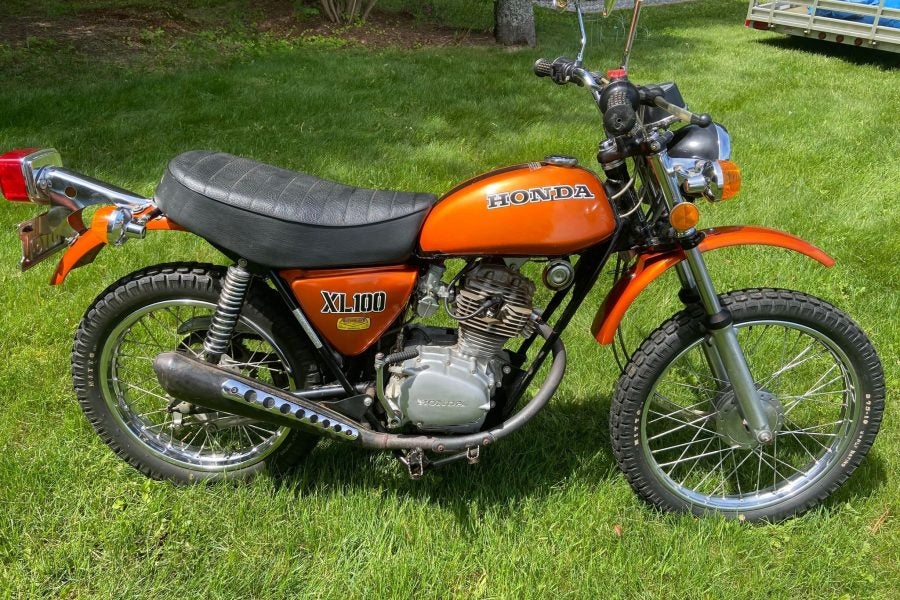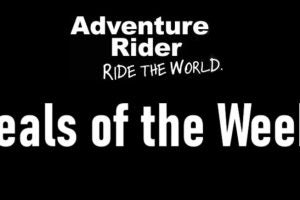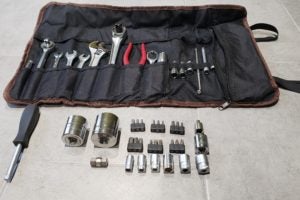How do you keep a dual sport in good condition over 40-plus years? Easy: You just don’t ride it. And that’s what we see here, with a 1974 Honda XL100 that saw a few miles, then sat unused for decades, under the same ownership. It’s one of the nicest first-generation XLs you’ll ever see, if you’re looking to own a piece of history that could arguably be called the direct ancestor of all today’s dual sport machines.
- Photo: Chris Maillet
- Photo: Chris Maillet
Different strokes
It’s the early 1970s, and the Japanese motorcycle manufacturers are quickly muscling the British out of the showroom. In particular, Honda has decided to target every market segment in the world of motorcycling. Along with bikes like the CB550 and CB750, which displaced big-bore machines like the BSA Lightning series or the Triumph Thunderbird, Honda builds small-cc dirt bikes, scramblers and dual sports. These fill roughly the same niche as the BSA Bantam and other lightweight street-and-trail bikes. But, while Europe often used two-strokes engines for those machines (often based on the old DKW RT 125 design), Honda used four-strokes. In the early 1970s, Honda had the SL series, which evolved into the TL series of trials bikes, and the XL dual sports. The air-cooled two-valve OHC engine in the XL100 here is basically an updated SL100 single-cylinder.
- Photo: Chris Maillet
- Photo: Chris Maillet
- Photo: Chris Maillet
Even the rest of the Japanese competition was still using two-strokes for their small-cc and even their middleweight enduros (as dual sports were called then). That didn’t change until the late 1970s or early 1980s, so Honda was really blazing some territory here. That’s amusing, as the bike itself is certainly no technical tour de force, and performance was limited. The XL100 made about 10 horsepower and 5 pound-feet of torque, and that suspension (twin rear shocks) was certainly limited even compared to the most basic dual sports available today. There was a 19-inch front wheel and 17-inch rear, with drum brakes at both ends. This was no race bike.
A solid performer
So why would you buy an XL100 in 1974? Because it was fun, simple and reliable.
Even in the early 1970s, Honda had a strong reputation; the Beach Boys sang about their “Little Honda,” not their “Little Hodaka.” And in overseas markets, just like today, machines like the XL100 made even more sense. Whether you were on an Asian goat path or cobblestoned streets in Europe, little bikes like this were always more popular outside North America, in areas where distances traveled were shorter, roads were more bumpy, or riders didn’t have enough money to even dream of a four-cylinder roadburner. They didn’t want a high-strung enduro bike; they just needed to get to work, or head to back-country trout lakes, or check a fence in the back pasture. In the days before ATVs, machines like this filled many of the roles that quads do now, since they were cheap and easy to ride over rough terrain.

Photo: Chris Maillet
Those years of solid performance really built Honda into the brand it is today. Even non-riders could see Big Red’s bikes were tough and dependable, and many of these XLs soldiered on for decades, until riders could no longer find parts or justify the expense of repairs.
Take a look through ADVrider’s archives, and you’ll see many forum references to these machines; this Vintage Singles thread is a good place to start. Despite their lack of speed, many inmates have fond memories of starting out on these bikes.

Photo: Chris Maillet
This bike here?
The machine in these pics is for sale in New Brunswick, on Canada’s east coast. See the seller’s description below:
I am selling my 1974 Honda xl100 enduro, this bike is completely original including the tires other than aftermarket replica mirrors with only 855 original miles since new. I purchased this from the original owner last year and have papers in my name. This would be a nice piece to add to a vintage motorcycle collection.
Note that the seller doesn’t want to ship the bike to the US or otherwise deal with cross border hassles. Maybe you could talk him to shipping somewhere in Canuckistan, but American buyers had better show up in person with cash, if they want it.
It’s pretty close to the US border, though (about 90 minutes north of Maine), so if you’re looking to get a vintage bike in unmolested condition (even the original tires!), this could be a weekend road trip for a New England resident. It’s for sale on Facebook here; contact the owner through that advert.












